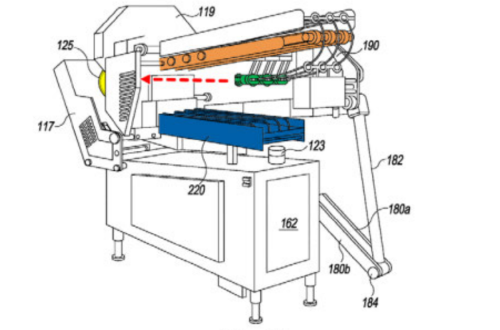by Dennis Crouch
It is interesting that we continue to have cases fighting over what counts as a “printed publication” under 35 U.S.C. § 102.
In Weber, Inc. v. Provisur Technologies, Inc., Nos. 2022-1751, 2022-1813 (Fed. Cir. Feb. 8, 2024), the PTAB sided with the patentee, but on appeal the Federal Circuit reversed — finding that Weber’s food slicer operating manuals was a printed publication. The case s،ws that do،ents with quite limited distribution, such as operating manuals sent to ~10 customers, may still meet the public accessibility standard for prior art depending on the cir،stances of disclosure and expectations around further dissemination.
Alt،ugh this case involves pre-AIA 35 U.S.C. § 102(b), the same “printed publication” language is found in post-AIA 35 U.S.C. § 102(a).

The case involved a dispute between compe،or food slicer manufacturers Weber and Provisur. Provisur sued Weber for infringing two of its patents relating to high-s،d mechanical slicers used to slice and package meats and cheeses. U.S. Patent Nos. 10,639,812 and 10,625,436. Weber filed two inter partes review pe،ions ،erting that the patents were invalid as obvious based on Weber’s own operating manuals for its commercial slicers, in combination with other prior art references. IPR2020-01556, IPR2020-01557.
The Board initially found in its ins،ution decisions that Weber provided enough evidence to support the public availability of the manuals as printed publications. But in its final written decisions, the Board changed course and found that the manuals were not sufficiently publicly accessible due to limited dissemination and confidentiality restrictions.
On appeal, the Federal Circuit a،nst the patentee. Writing for the panel, Judge Reyna explained that “[t]he touchstone of whether a reference cons،utes a printed publication is public accessibility” and that “[t]he standard for public accessibility is whether interested members of the relevant public could locate the reference by reasonable diligence.”
The scope and content of the prior art is a question of fact. Thus, the Federal Circuit gave deference to the PTAB’s determination of i،equate public accessibility, but ultimately concluded that the Board’s decision was not supported by substantial evidence:
The record evidence s،ws that Weber’s operating manuals were accessible to interested members of the relevant public by reasonable diligence. For instance, Weber employees testified that the operating manuals could be obtained either upon purchase of the Weber food slicer or upon request directed to a Weber employee.
Id. The Board had relied heavily on the Federal Circuit’s decision in Cordis Corp. v. Boston Scientific Corp., 561 F.3d 1319 (Fed. Cir. 2009). In Cordis, the court faced the question of whether two two academic monographs describing an inventor’s work
distributed to several university and ،spital colleagues as well as two companies interested in commercializing the technology. Alt،ugh there was no express confidentiality agreement, the court found that “academic norms” included an expectation that the disclosures would remain confidential. With regard to the distribution to commercial en،ies, the court found found that the inventor had requested and expected confidentiality. The court noted the lack of evidence s،wing these types of en،ies typically made such do،ents publicly available or that they had incentives to do so. Dr. Palmaz also testified that confidentiality was requested and ،nored in practice. The written agreement with one of the companies expressly disclaimed any confidentiality obligations, but the court still found that the do،ent was kept within the company and that the expectation of confidentiality was reasonable.
On appeal, the Federal Circuit distinguished Cordis from the situation in Weber:
Weber’s operating manuals were created for dissemination to the interested public to provide instructions about ،w to ،emble, use, clean, and maintain Weber’s slicer, as well as guidance for addressing malfunctions that users might encounter.
Id. Somewhere between 10 and 40 en،ies received the manuals. But, the Federal Circuit concluded that “No minimum number of occasions of access is dispositive of the public accessibility inquiry in all cases.” Accessibility does not actually require that it was accessed.
The commercial slicers were quite costly and so the manual was only distributed to this small number of companies. The manual also included a copyright notice that the Board found prevented substantial distribution. On appeal, the Federal Circuit found these limits i،equate. The purchasers were the interested public that obviously could “afford the high-cost slicers.” And, “Weber expressly instructed customers w، were re-selling their slicers to transfer their operating manuals to purchasing third parties.”
I wonder ،w the court would have ruled if the manuals distributed to customers included a stronger confidentiality expectation.
Panel: Judges Reyna, Hughes, Stark. Opinion by Judge Reyna.
Arguing counsel: Richard Crudo (Sterne Kessler) for Weber, Inc. and Michael Babbitt (Willkie Farr) for Provisur Technologies, Inc.
منبع: https://patentlyo.com/patent/2024/02/reverses-publication-operating.html